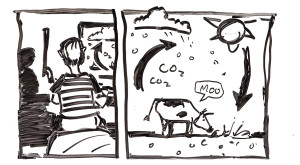 In Chem+C project, we develop activities that combine Chemistry and Computational Thinking (CT) in an 8th Grade Integrated Science context. We do this through asking students to work with both visual, modifiable, runnable representations of models of earth-science systems and the associated code-based models. Student experiences with both Chemistry and CT will be embedded in a pedagogy of structured scientific argumentation that focuses on the production of evidence-based reasoning.
In Chem+C project, we develop activities that combine Chemistry and Computational Thinking (CT) in an 8th Grade Integrated Science context. We do this through asking students to work with both visual, modifiable, runnable representations of models of earth-science systems and the associated code-based models. Student experiences with both Chemistry and CT will be embedded in a pedagogy of structured scientific argumentation that focuses on the production of evidence-based reasoning.
The best way to learn about our concept from a non-technical point of view is by looking at this 3-1/2 minute video:
The idea:
By interacting with, contrasting and arguing about the visual and code-based representations of models, students will learn about both particular chemical systems and CT. They will modify and adapt the code, making predictions about the effects on the visual model. They will learn about key concepts such as oxydation-reduction reactions, and the movement of carbon through between states and settings.
The approach is unique in its combination of prioritization of a process of structured student argumentation in combination with both scientific content and CT. The research will investigate this approach, creating relevant, reusable performance assessments as well as activities including computer models and related curricular materials.
The research also addresses how students learn, through examination of their discourse and actions with respect to the computer models and pre/post testing using the learning assessments developed and validated during the project. It addresses teacher learning through extensive professional development, involvement of teachers with the development and use of materials, and tracing their growth of understanding.

Screenshot from a modified NetLogo application [1,2]
This research is important for STEM learning, computing and the field because we are building a promising novel suite of products through iterative design that utilizes argumentation as an active process−acting as a catalyst to deeper student understanding and involvement with Chemistry and CT. These argumentation-focused products have significant potential to enhance the prospects that students may go on to have a long-term future in related fields. The products and the information we learn from both implementation and testing about student and teacher learning have promise to extend to a range of CT topics and STEM areas, especially where modeling is or could be used.
The CHEM+C project is a product of the ThirdLab at Virginia Tech and the Department of Curriculum and Instruction at University of Texas, Austin. The CHEM+C project is part of larger programmes of research at both institutions. At Virginia Tech, it continues and parallels other on-going work on the Integrated Computational Thinking approach. At UT Austin, it continues and parallels on-going work on argumentation in science learning.
The technological environment that we utilize is NetLogo [1,2], with thanks to the Center for Connected Learning and Computer-Based Modeling at Northwestern University.
Thanks to the National Science Foundation for Grant Number 1543022!